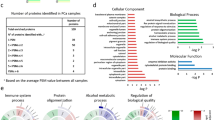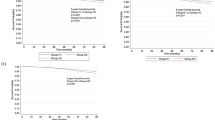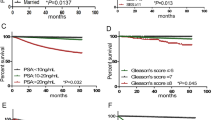Abstract
Background:
Prostate cancer (PCa) patients are often over-treated because of the lack of biomarkers needed to distinguish the lethal from the indolent form of PCa. YWHAZ was recently identified as a potential therapeutic target in castration-resistant PCa (CRPC). Therefore, this study focused on determining the prognostic significance of YWHAZ in localized PCa.
Methods:
YWHAZ expression was assessed by immunohistochemistry on formalin-fixed paraffin-embedded tissue from 213 men who underwent radical prostatectomy. Kaplan–Meier analysis and Cox proportional-hazards models were used to assess the prognostic value of YWHAZ intensity.
Results:
High YWHAZ expression was strongly associated with high Gleason score at the time of diagnosis (P<0.001) and PSA relapse (P=0.001). Importantly, patients with high expression of YWHAZ had a higher risk of CRPC development (P=0.002) and reduced survival time (P=0.002).
Conclusions:
Our findings indicate that YWHAZ could serve as a promising prognostic biomarker in localized PCa to predict poor prognosis and to identify a subgroup of tumors, which might benefit from earlier adjuvant or YWHAZ-targeted therapy.
This is a preview of subscription content, access via your institution
Access options
Subscribe to this journal
Receive 4 print issues and online access
$259.00 per year
only $64.75 per issue
Buy this article
- Purchase on Springer Link
- Instant access to full article PDF
Prices may be subject to local taxes which are calculated during checkout


Similar content being viewed by others
References
Siegel R, Naishadham D, Jemal A . Cancer statistics, 2013. CA Cancer J Clin 2013; 63: 11–30.
Turkbey B, Mena E, Aras O, Garvey B, Grant K, Choyke PL . Functional and molecular imaging: applications for diagnosis and staging of localised prostate cancer. Clin Oncol 2013; 25: 451–460.
Sanda MG, Dunn RL, Michalski J, Sandler HM, Northouse L, Hembroff L et al. Quality of life and satisfaction with outcome among prostate-cancer survivors. N Engl J Med 2008; 358: 1250–1261.
Schwartz KL . Alibhai, Shabbir MH, Tomlinson G, Naglie G, Krahn MD. Continued undertreatment of older men with localized prostate cancer. Urology 2003; 62: 860–865.
Tzivion G, Gupta VS, Kaplun L, Balan V . 14-3-3 proteins as potential oncogenes. Semin Cancer Biol 2006; 16: 203–213.
Gardino AK, Smerdon SJ, Yaffe MB . Structural determinants of 14-3-3 binding specificities and regulation of subcellular localization of 14-3-3-ligand complexes: a comparison of the X-ray crystal structures of all human 14-3-3 isoforms. Semin Cancer Biol 2006; 16: 173–182.
Matta A, Siu KW, Ralhan R. 14-3-3 zeta as novel molecular target for cancer therapy. Expert Opin Ther Targets 2012; 16: 515–523.
Bajpai U, Sharma R, Kausar T, Dattagupta S, Chattopadhayay TK, Ralhan R . Clinical significance of 14-3-3 zeta in human esophageal cancer. Int J Biol Markers 2008; 23: 231–237.
Matta A, Bahadur S, Duggal R, Gupta SD, Ralhan R . Over-expression of 14-3-3zeta is an early event in oral cancer. BMC Cancer 2007; 7: 169.
Matta A, DeSouza LV, Shukla NK, Gupta SD, Ralhan R, Siu KW . Prognostic significance of head-and-neck cancer biomarkers previously discovered and identified using iTRAQ-labeling and multidimensional liquid chromatography-tandem mass spectrometry. J Proteome Res 2008; 7: 2078–2087.
Fan T, Li R, Todd NW, Qiu Q, Fang H, Wang H et al. Up-regulation of 14-3-3zeta in lung cancer and its implication as prognostic and therapeutic target. Cancer Res 2007; 67: 7901–7906.
Yang X, Cao W, Zhou J, Zhang W, Zhang X, Lin W et al. 14-3-3zeta positive expression is associated with a poor prognosis in patients with glioblastoma. Neurosurgery 2011; 68: 932–938.
Neal CL, Yao J, Yang W, Zhou X, Nguyen NT, Lu J et al. 14-3-3zeta overexpression defines high risk for breast cancer recurrence and promotes cancer cell survival. Cancer Res 2009; 69: 3425–3432.
Neal CL, Yu D . 14-3-3zeta as a prognostic marker and therapeutic target for cancer. Expert Opin Ther Targets 2010; 14: 1343–1354.
Menon R, Deng M, Ruenauver K, Queisser A, Offermann A, Boehm D et al. Somatic copy number alterations by whole exome sequencing implicates YWHAZ and PTK2 in castration-resistant prostate cancer. J Pathol 2013; 231: 505–516.
Nowak M, Svensson MA, Carlsson J, Vogel W, Kebschull M, Wernert N et al. Prognostic significance of phospho-histone H3 in prostate carcinoma. World J Urol 2013; 32: 703–707.
Scheble VJ, Braun M, Beroukhim R, Mermel CH, Ruiz C, Wilbertz T et al. ERG rearrangement is specific to prostate cancer and does not occur in any other common tumor. Mod Pathol 2010; 23: 1061–1067.
Braun M, Kirsten R, Rupp NJ, Moch H, Fend F, Wernert N et al. Quantification of protein expression in cells and cellular subcompartments on immunohistochemical sections using a computer supported image analysis system. Histol Histopathol 2013; 28: 605–610.
Bangma CH, Roemeling S, Schroder FH . Overdiagnosis and overtreatment of early detected prostate cancer. World J Urol 2007; 25: 3–9.
Niemantsverdriet M, Wagner K, Visser M, Backendorf C . Cellular functions of 14-3-3 zeta in apoptosis and cell adhesion emphasize its oncogenic character. Oncogene 2008; 27: 1315–1319.
Murata T, Takayama K, Urano T, Fujimura T, Ashikari D, Obinata D et al. 14-3-3zeta, a novel androgen-responsive gene, is upregulated in prostate cancer and promotes prostate cancer cell proliferation and survival. Clin Cancer Res 2012; 18: 5617–5627.
Harman SM, Metter EJ, Tobin JD, Pearson J, Blackman MR . Longitudinal effects of aging on serum total and free testosterone levels in healthy men. Baltimore Longitudinal Study of Aging. J Clin Endocrinol Metab 2001; 86: 724–731.
Acknowledgements
This work was supported by grants from the Wilhelm Sander Foundation (2011.077.1), the Rudolf-Becker-Foundation and the German Research Foundation (Deutsche Forschungsgemeinschaft (DFG), Emmy-Noether-Program, PE1179/2-1) to SP. Furthermore, the project was supported by the medical student research grant of the Medical Faculty of the University of Bonn (BONFOR) to KR.
Author information
Authors and Affiliations
Corresponding author
Ethics declarations
Competing interests
The authors declare no conflict of interest.
Rights and permissions
About this article
Cite this article
Rüenauver, K., Menon, R., Svensson, M. et al. Prognostic significance of YWHAZ expression in localized prostate cancer. Prostate Cancer Prostatic Dis 17, 310–314 (2014). https://doi.org/10.1038/pcan.2014.32
Received:
Revised:
Accepted:
Published:
Issue Date:
DOI: https://doi.org/10.1038/pcan.2014.32
This article is cited by
-
CircCDK17 knockdown inhibits tumor progression and cell glycolysis by downregulaing YWHAZ expression through sponging miR-1294 in cervical cancer
Journal of Ovarian Research (2022)
-
The expression of YWHAZ and NDRG1 predicts aggressive outcome in human prostate cancer
Communications Biology (2021)
-
MiRNA-802 suppresses proliferation and migration of epithelial ovarian cancer cells by targeting YWHAZ
Journal of Ovarian Research (2019)
-
Systems pharmacology using mass spectrometry identifies critical response nodes in prostate cancer
npj Systems Biology and Applications (2018)



